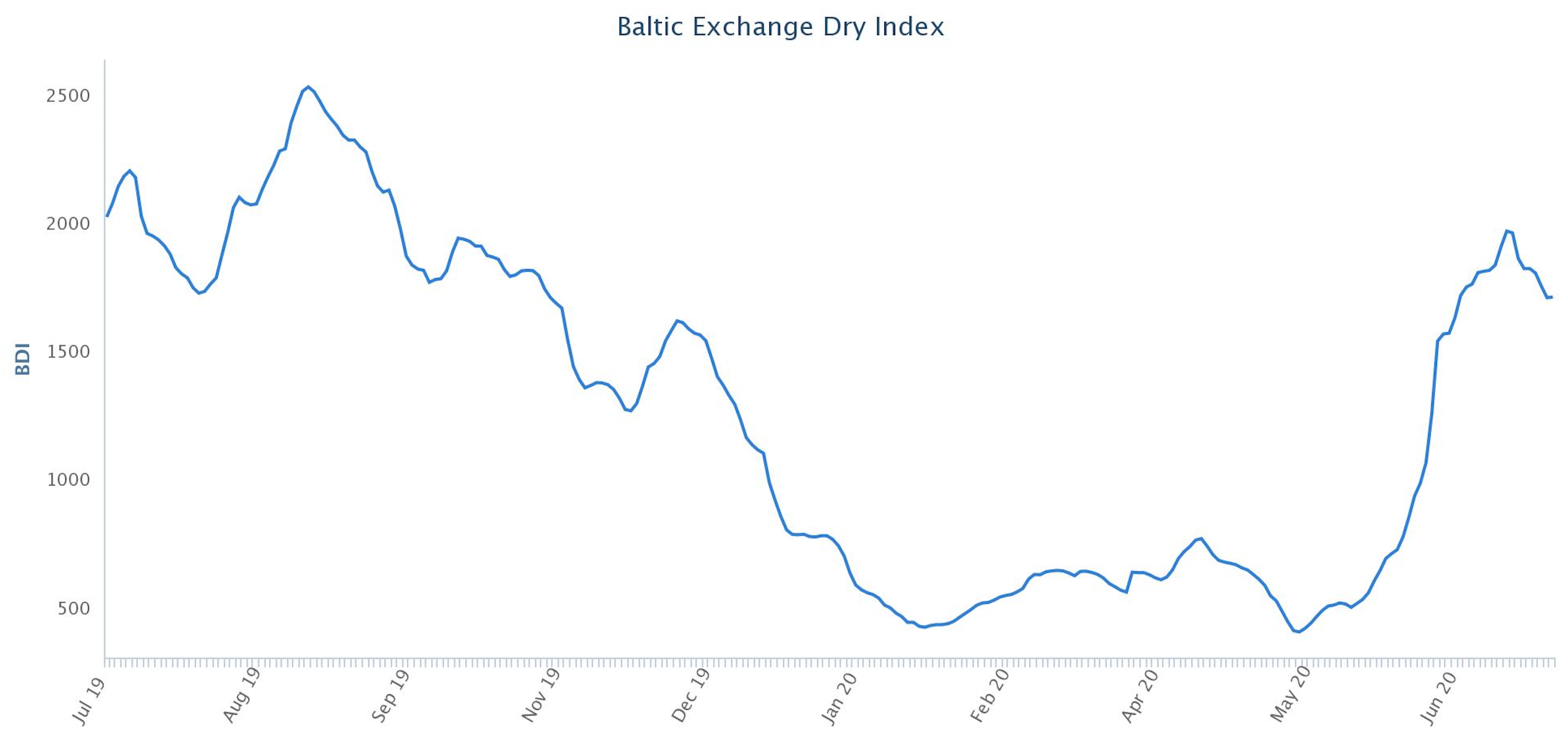BEIJING, July 20 (Xinhua) -- The Baltic Exchange has launched its newly designed website on Monday offering better access to Baltic data.
Specifically, "My Baltic" area on the new site allows seamless Baltic data access for Baltic APP users, who can use same APP login information for web-version access, according to release by Baltic Exchange.
Headquartered in London and a subsidiary of the Singapore Exchange (SGX), the Baltic Exchange publishes a range of indices and assessments which provide an accurate and independent benchmark of the cost of transporting commodities and goods by sea. These include the Baltic Dry Index (BDI), the dry bulk shipping industry's best known indicator. Published daily since 1985, this provides a snapshot of the daily spot market earnings of capesize, panamax and supramax vessel types on the world's key trading routes.

Chart shows Baltic Dry Index (BDI) during July 17, 2019 to July 17, 2020
In March 2018 the BDI was re-weighted and is published using the following ratios of timecharter assessments: 40 percent capesize, 30 percent panamax and 30 percent supramax. The information is provided by a panel of international shipbrokers.
The Baltic Exchange alsopublished its weekly report of the dry and tanker markets for July 13-17, 2020 as below:
Capesize
The capesize market showed some resistance this week to recent losses as all routes saw a small uptick in value to end the week. With no particular improvement in fundamentals - and a relatively quiet fixing week - owners may have shown enough collective resilience to have turned the tide. A backwardation in forward curve illustrating a capesize 5TC spot level from today of $25,085, down to Q4 at $17-18k, gives an indication of market confidence. This lack of confidence may be offset as the recent rally has been driven in part by tightness in shipping positions, which is sure to continue in this unique 2020 year. Minimal tonnage remains in the Atlantic making it prone to spiking. But a lack of West Africa cargo due to the rainy season is helping to relieve any pressure that may build. The Atlantic basin has widened its premium over the Pacific to a difference of $9,532. The West Australia to Qingdao C5 shed more than 80 cents to settle end of week at $8.132. The Brazil to China C3 encountered similar pressure dropping 79 cents to post at $18.295.
Panamax
A muted week in the panamax market with rates easing in all areas as the week progressed. A vast difference of opinion built up on where the true values sat and consequently, the bid/offer spread widened with fixing volumes down on the week. In the Atlantic, with reduced activity out of EC South America and longer duration trans-Atlantic business lacking, the short Baltic and Kamsar round trips appeared popular with some to take cover. Rates for Baltic rounds at the beginning of the week marked at $20,000 pegged back closer to $16/15,000 by end week. Despite less salvation from EC South America and weaker FFA values, there was less of a decline in rates out of Asia. However, easier rates were certainly concluded over the week - including an 82,000dwt delivery China fixing at $12,500 for a NoPac round trip. The rate on Friday was more akin to $11,500 for the same.
Ultramax/Supramax
Positive movement for the BSI again during the week. But as it ended, sentiment wavered from areas such as the US Gulf and east Mediterranean with limited fresh activity. Period activity was limited, but a 62,000-dwt newbuilding scrubber fitted was fixed for five to eight months trading at $13,000. From the Atlantic, a 62,000dwt was fixed delivery Recalada for a trans Atlantic in the mid $17,000s. Further north, a 61,000dwt was reported fixed from the US Gulf for a petcoke run via India redelivery Durban at $20,000. The Continent was patchy, but a 61,000dwt fixed a scrap run to the east Mediterranean at around $16,000. From Asia gains were made. A 63,000 open north China fixing an Australian round in the low $10,000s. Elsewhere, a 56,000dwt fixed from south east Asia via Indonesia redelivery east coast India in the mid $8,000s. The Indian Ocean lacked fresh impetus but a 58,000dwt fixed from the Arabian Gulf to Bangladesh at $16,000.
Handy
There was talk of higher numbers from the Continent and Mediterranean, with more activity reported in the second half of the week. Mediterranean the HS3 route from east coast South America climbed over $12,000 this week and is now at the highest point of the year. The US Gulf market continued the trend from last week and remained firm, but the Pacific showed more signs of slowing down with little gossip emerged. A 37,000dwt delivery US east coast was fixed for moving petcoke to east coast Mexico at $12,500 and a 38,000dwt did a similar run at $15,000 basis Southwest Pass delivery. A 37,000dwt was booked for moving steels via the Black Sea to Egyptian Mediterranean at $7,250 basis Canakkale delivery. A 38,000dwt open in east Mediterranean was fixed for a trip to india at $17,500.
Clean
In the Middle East Gulf, rates for 75,000mt to Japan have been under relentless pressure. Pantos did fix at WS63 earlier in the week, but subsequently levels have slipped further with the market now assessed in the mid to high WS50s. It was a similar story in the 55,000mt trade, with the market losing eight points to settle at WS50. The 37,000mt UKC to USAC trade started the week at WS70 and a flurry of activity with a tighter list saw an improvement to low WS80s before the brief recovery was snuffed out and rates settled back to high WS70s. The one bright area for owners was again in the backhaul business from the US Gulf where the market gained almost 35 points to WS125 level. It was a lacklustre week in the 30,000mt clean cross-Med trade with rates stuck in the doldrums at WS80.
VLCC
Rates in this sector fell back slightly, with 280,000mt Middle East Gulf to USG via the Cape/Cape routing assessed one to two points lower at WS24 and 270,000mt to China now sits at WS42.5 level, down four points. As with last week, we saw this rate movement mirrored in the Atlantic, where 260,000mt West Africa to China is at WS42.5. Nevertheless, ENI are today reported to have fixed on subjects at WS43.75. Voyages of 270,000mt US Gulf to China are now rated at $5.95m region - $700k lower than a week ago.
Suezmax
Rates for 135,000mt Black Sea/Med have dipped to low WS50s, losing the 2.5-point gain from last week. The 130,000mt West Africa/UKCont market is also weaker and now sits at WS45, down six points. For the 140,000mt Middle East Gulf to Med trip, rates have modestly improved by a single point to WS22.
Aframax
In the Mediterranean, market rates have flattened at WS65-67.5 level for 80,000mt Ceyhan/Med. Improvements were seen in Northern European voyages where rates for 80,000mt Hound Point/UKCont saw an uptick of 21 points to WS92.5-95 region. Rates for 100,000mt Baltic/UKCont improved by 11 or so points to WS52.5. Across the Atlantic, the market has remained flat at WS 68.75 for 70,000mt Carib/USGulf and WS67.5 for 70,000mt USGulf/UKCont.
(Source: The Baltic Exchange, edited by Niu Huizhe with Xinhua Silk Road, niuhuizhe@xinhua.org)




 A single purchase
A single purchase









